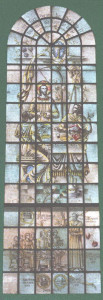He Took Bread And Blessed It And Brake And Gave To Them
This is the second Easter window. At first glance, it looks as though an error had been made in the installation of the windows, that this is a depiction of the Last Supper and is chronologically misplaced. But the sequence really is in proper order, for this window does not show the Last Supper at all, but rather the Supper at Emmaus on the evening of the resurrection day.
The quotation at the top of the window is from the Emmaus account (Luke 24:30). Jesus is shown breaking the bread in His hands, while the two disciples who accompanied Him to Emmaus sit at the table, finally recognizing Him, their hats and traveling staff hung up on the wall. The pitcher and bowl add to the confusion with the Last Supper, but these would also be a normal facility at any table for washing the dusty hands and feet of travelers. The traditional symbol of the Eucharist, however, the rayed chalice and host, appears at the top of the window.
Although it is not mentioned, the upper and lower portions of this window are tied together by the thought expressed in the hymn, “Break Thou the Bread of Life:’ which refers as much to the Word of God as it does to the Sacrament. For here is God’s Word being taught at the first Sunday School of our congregation, by Miss EIizabeth Pohlman in the spring of 1820. (Although the date of May 20, 1820 appears in the window, that was a Saturday, and our Sunday School records themselves give the date of Miss Pohlman’s first class as April 30, 1820.)
Elizabeth Pohlman was a sister of the Rev. Henry N. Pohlman, who in later years returned to Albany to become pastor of his home church. Henry Pohlman had the distinction of being the first theological student at Hartwick Seminary, when the latter was finally opened in Otsego County in 1815-16. At the bottom of the window are the seals of Hartwick Seminary (right) and Hartwick College (left), the Lutheran educational institutions on our territory whose history has been so interwoven with that of our congregation.
Our present church edifice was completed in 1954, in which year Albany had a local bicentennial celebration commemorating the Albany Congress of 1754, when Benjamin Franklin came here. The circular emblem at the left center of this window depicts the old Albany Stadt Huys (city hall), where the congress was held. The emblem itself was used during the 1954 observance, and was lettered around the rim: 1754 Albany Cradle of the Union 1954.
